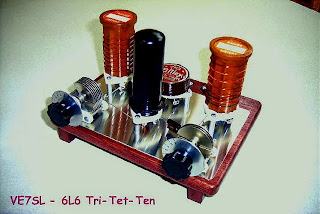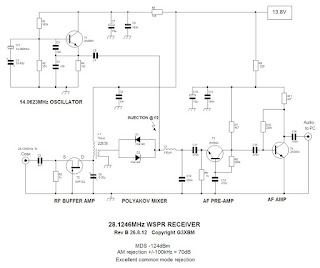Posts Tagged ‘10m’
 Monday FT8CN Decodes
Monday FT8CN Decodes
10m remains very active, this is todays activity at 2 different times.
Around 10:30z:
Around 13:55z:
Further details about FT8CN see my Blog https://g1kqh.blogspot.com/2023/02/ft8cn-new-free-android-app.html
 Bureau QSL Batch
Bureau QSL Batch

The batch of bureau cards last week included several cards from Europe and were probably the last I'll get for my Cycle 24 10m fun, using the homebrew Tri-Tet-Ten.
As mentioned previously, this rig was the culmination of wondering, for many many years, if I could get a single 6L6 to work well enough on 10m CW, using a 40m crystal ... quadrupling to 10m ... and still have enough useful output to work Europe! As well, the note would have to be 'acceptable' as I realized that any crystal chirping would be multiplied four times, during the quadrupling process.
The evolution of my eventual transmitter, is described in more detail here, where you can also hear what the tone sounds like. Suffice to say, the results were much more than I had ever hoped for and during the peak years of this past cycle, many enjoyable hours were spent on 10m CW with my one tube tri-tet crystal oscillator.
I guess I could always move down to 20m CW but, for me, this just doesn't have the same appeal or sense of satisfaction as using it on 10m or what I like to call, "the other magic band". Who knows what Cycle 25 will bring to 10m? I may get another chance yet, if the solar prognosticators are all wrong!
 SLOWLY declining solar activity
SLOWLY declining solar activity
The slide down from a solar maximum is (usually) slower than the climb from the minimum to the maximum. Very gradually, the sun is going “off the boil” and solar activity is slowly falling away. With each year for several years to come things will get progressively harder on the higher bands. Some are predicting the next maximum may be a “damp squib”, so enjoy the conditions while they last. It is quite possible that 10m will never be as good again in the lifetimes of many of us. Certainly 10m is already not as good as a year ago. Although Es is good at any part of the cycle in late spring and summer, F2 DX is best around the peak of solar activity. In the past 6m has supported worldwide DX at times, but I think those days are sadly over.
 Simple 28MHz WSPR (or PSK31) RX
Simple 28MHz WSPR (or PSK31) RX
Facebook is throwing up memories from 3 years ago and one of these was a schematic for my WSPR RX for 10m, using low cost 14.060MHz crystals with a Polyakov mixer (injection at half signal frequency) The circuit worked well and could also be used for PSK31. Essentially this is a direct conversion receiver, but it mattered not. Even if you bought all parts new it is very inexpensive. 3 years later I would replace the 2 diodes by Schottky ones as these are now low cost and need less injection than the silicon ones shown.
 Lincoln President Mk2
Lincoln President Mk2
 I have owned this rig for several months now but it hardly get used as I prefer, because of my poor voice, to run my WSPR beacon on 10m. It certainly works well with my last QSO being a W8 on SSB.
I have owned this rig for several months now but it hardly get used as I prefer, because of my poor voice, to run my WSPR beacon on 10m. It certainly works well with my last QSO being a W8 on SSB.
In the picture, the small WSPR beacon is far left with the Lincoln with green illumination on the left of the FT817s and to the right of the WSPR beacon.
 10m – my best band of all
10m – my best band of all
10m has always been my best band. I have lost count of the DXCC totals with QRP SSB. Chasing countries has never been a real activity of mine, although I still get a “kick” from working a new country.
At sunspot peaks it supports world-wide DX with QRP and simple wire antennas. Even in the quiet solar years there is often some DX to be found and usually late April to September there is sporadic-E (Es) to be found with good signals over ranges up to around 1500km and sometimes further. These are for the northern hemisphere. There tends to be a smaller Es peak around December/January. It is the reverse in the southern hemisphere. It is quite normal to hear USA stations by Es in the summertime, but usually openings are not for long.
If 10m is quiet it is worth checking CB frequencies (11m) as a “band open” sign. Often CB can be busy when 10m is quiet due to lack of activity. Thanks to Steve VE7SL for this good advice.
At night and in the quiet years it is an ideal band for local nets on FM or AM. At 1.7MHz wide it is big band so all modes can be supported.
See https://sites.google.com/site/g3xbmqrp3/hf/10m_op .
 WISPY 10m WSPR rig
WISPY 10m WSPR rig
Some years ago (in my fit days) I build a simple DSB WSPR rig for 10m based around a low cost 14.060MHz crystal bought from the GQRP club. The idea was to pull and double this crystal and use it in a simple DSB TX and direct conversion RX. Both TX and RX have been built separately, but I was ill before I got around to combining the 2 into a 10m WSPR transceiver. Both parts worked well.
.jpg)
















